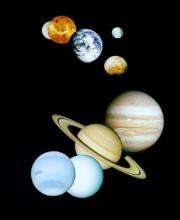July: Planets to create a celestial chorus line in the west

(PhysOrg.com) -- The western sky will be crowded after sunset in July. Forming a long slanting line from highest to lowest above the horizon will be the planets Saturn, Mars and Venus, with the bright star Regulus included as well.
Brilliant white Venus will dominate the scene, shining low in the west-southwest an hour after sunset. The gleaming planet will be 40 times brighter than the most conspicuous stars in the evening sky. Venus will become even more dazzling as the month passes, far outshining the stars of the constellation Leo the Lion as it moves among them. On July 9, Venus will be just a degree north of Leo's brightest star, Regulus. By month's end, Venus will be closing in on Mars and Saturn to its upper left (south).
Mars, a hundred times fainter than Venus, will be easy to identify by its red-orange color, contrasting with the pale yellow of Saturn farther to the left. The two will be well separated at the start of the month, but the gap between them will close rapidly, and they will be only a couple of degrees apart at month's end. Mars will not show much detail in a telescope, but Saturn's rings and larger moons will put on a good show starting about an hour after sunset.
Around the middle of the month, Mercury will emerge from the afterglow of sunset low in the west-northwest, adding a fourth planet to the celestial chorus line. Mercury will be very close to Regulus on the evening of July 27. Binoculars may be needed to see this conjunction.
Jupiter will rise around the time Saturn sets, a little after midnight at the start of the month and about 10:30 p.m. EDT by month's end. Appearing well above the eastern horizon as a beautiful "morning star" in the brightening sky, Jupiter will get higher and brighter as the month passes. Its four largest moons will be on the same side of the planet on July 5, 8 and 18.
Meteor shower
The southern branch of the Delta Aquarid meteor shower will peak before dawn on July 28, just three days after full moon. Meteors will appear several nights before and after the peak as well. The long bright streaks will seem to come from a point in the constellation Aquarius in the southern sky during the hours just before morning twilight. In a dark sky there should be about 10 meteors per hour at the peak, but this time moonlight will wash out all but the brightest meteors.
Aphelion
On July 6, Earth will reach its greatest distance from the sun for the year, called aphelion. Those sweltering in summer heat in the Northern Hemisphere may find it hard to believe that they are about 3 percent farther from the sun than they were in January. Those experiencing winter in the Southern Hemisphere will be easier to convince. The difference is caused by the tilt of Earth's axis. The part of the planet tilted toward the sun is much warmer than the part tilted away, because more sunlight reaches the ground instead of being absorbed by the atmosphere.
Moon phases
The moon will be at third quarter on July 4, new on July 11, at first quarter on July 18 and full on July 25.
Provided by Indiana University





















